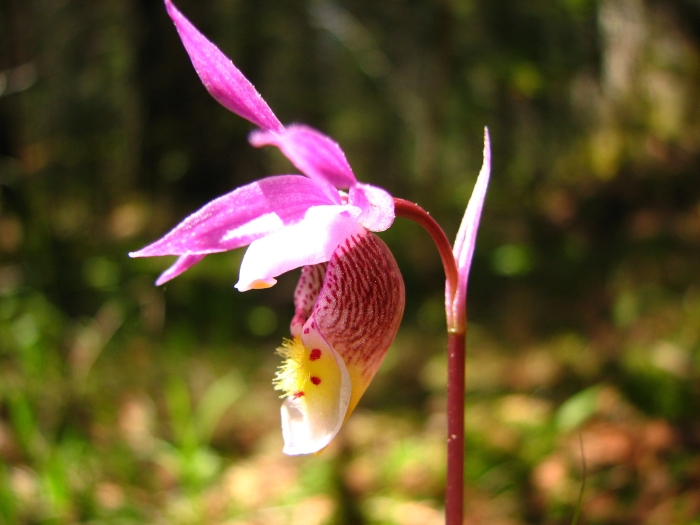Calypso Orchid
(Calypso bulbosa)
Calypso Orchid (Calypso bulbosa)
/
/

Norma Malinowski
CC BY 4.0
Image By:
Norma Malinowski
Recorded By:
Copyright:
CC BY 4.0
Copyright Notice:
Photo by: Norma Malinowski | License Type: CC BY 4.0 | License URL: http://creativecommons.org/licenses/by/4.0/ | Rights Holder: Norma Malinowski | Publisher: iNaturalist | Date Created: 2009-06-03T12:01:23-07:00 |






















Estimated Native Range
Summary
Calypso bulbosa, commonly known as the calypso orchid or fairy slipper, is a perennial herbaceous orchid native to cool, temperate forests, including boreal forests, moist coniferous woodlands, and mixed deciduous forests. It is found across much of North America, Northern Europe, and Asia. This delicate orchid typically grows 3-8 inches tall and features a single, basal leaf. The flower, blooming from May to June, is notable for its striking appearance: a pouch-like pink, purple, or red bloom with a distinct white lip and a contrasting yellow beard, which is quite showy despite the plant’s small size.
The calypso orchid is valued for its unique beauty and is a fascinating addition to shade gardens, especially those designed to mimic natural woodland settings. It requires a well-drained, humus-rich soil that stays moist but not waterlogged, and thrives in dappled shade. Due to its reliance on specific mycorrhizal fungi for germination and growth, it is not easily cultivated and is best appreciated in its natural habitat. The plant is sensitive to disturbance and is considered threatened or endangered in several regions, partly due to habitat loss and the collection from the wild. Gardeners interested in this plant should seek out nursery-propagated specimens to ensure conservation of wild populations.CC BY-SA 4.0
The calypso orchid is valued for its unique beauty and is a fascinating addition to shade gardens, especially those designed to mimic natural woodland settings. It requires a well-drained, humus-rich soil that stays moist but not waterlogged, and thrives in dappled shade. Due to its reliance on specific mycorrhizal fungi for germination and growth, it is not easily cultivated and is best appreciated in its natural habitat. The plant is sensitive to disturbance and is considered threatened or endangered in several regions, partly due to habitat loss and the collection from the wild. Gardeners interested in this plant should seek out nursery-propagated specimens to ensure conservation of wild populations.CC BY-SA 4.0
Plant Description
- Plant Type: Herb, Bulb
- Height: 0.3-0.8 feet
- Width: 0.1-0.2 feet
- Growth Rate: Slow
- Flower Color: Pink, Purple, White
- Flowering Season: Spring
- Leaf Retention: Deciduous
Growth Requirements
- Sun: Part Shade, Full Shade
- Water: Medium
- Drainage: Medium
Common Uses
Low Maintenance, Potted Plant, Rock Garden
Natural Habitat
Cool, temperate forests, including boreal forests, moist coniferous woodlands, and mixed deciduous forests
Other Names
Common Names: Fairy Slipper Orchid, Venus’s Slipper, Fairy Slipper, Calypso Orchid, Deer’s Head Orchid
Scientific Names: , Calypso bulbosa, ? borealis, Calypso borealis, Calypso bulbosa f. bulbosa, Calypsodium boreale, Cymbidium boreale, Cypripedium bulbosum, Cytherea borealis, Cytherea bulbosa
GBIF Accepted Name: